Check out my custom vibration dampener
7 Best Cheap Tennis Shoes
For Men & Women in 2024
We hope you love this article. Just so you know, TennisCompanion may collect a small share of sales from the links on this page to help keep this site running. Learn more.
Despite what many players and marketers tell you, you don’t need to spend much money to get quality tennis shoes.
If you’re learning how to play tennis, a pair of cheap tennis shoes might be the ideal choice, but there are also some reasons you might consider springing for a high-end shoe.
This guide discusses what makes a great tennis shoe, covers the differences between affordable and expensive shoes, and shares my favorite pairs for men and women in 2024.
Article Contents
Click below to jump to a section
Tap below to jump to a section
What Makes a Great Shoe
Expensive vs. Cheap Shoes
Expensive Shoes for Less
Where to Buy Cheap Shoes
7 Men’s Shoes
7 Women’s Shoes
New to TennisCompanion?
Create a free account and explore my latest videos below
What Makes a Great Tennis Shoe

Purchasing tennis shoes that protect your feet and support longevity on the court is crucial regardless of how much you spend.
Luckily, you don’t need to spend much, but there are a few key features to consider when buying a cheap pair of tennis shoes.
All the shoes I’ve selected to share in this guide meet these criteria, but let’s look at each and why they’re essential.
Stability
One of the most critical features of a tennis shoe is stability, which is necessary because of the typical multi-directional movements a player will move through when hitting.
As a tennis player, you’ll move forward, backward, side to side, and diagonally – frequently with quick starts and abrupt stops.
As a result, the shoe you’re wearing must be stable to support your feet and ankles to prevent injury.
Traction
Right behind stability, traction is another essential ingredient for a great pair of tennis shoes.
Like stability, traction helps ensure solid footing as you move around the court, especially as a player makes quick or sharp movements. Two components help give a tennis shoe proper traction.
First, the rubber material of the outsole contributes to traction, so manufacturers have to strike a balance when aiming for the optimal rubber compound. If it’s too soft, it will lack durability and wear quickly. Conversely, it will be slick and dangerous if it’s too stiff.
Second, the tread pattern also affects how well the shoe grips the court and can differ depending on the surface.
- Hard Courts: You’ll find the most variety in the tread patterns with shoes for hard courts. However, manufacturers use a herringbone pattern or a variation on the herringbone pattern more often than not. This pattern works well for hard courts and transitions nicely to clay and grass for players who periodically mix up their court surfaces.
- Clay Courts: Some tennis shoe models offer clay court versions with a herringbone pattern throughout the entire length of the shoe’s bottom. This pattern provides the best traction on clay and helps ensure consistent and confident slides while naturally releasing debris as a player moves around the court.
- Grass Courts: Although grass courts are the least common, you can still find them in certain areas where the environment is ideal. Grass court tennis shoes include small studs or pimples on the outsole, providing superior traction for the surface. However, the tread has to be subtle to avoid causing excessive wear to the courts.
Most inexpensive tennis shoes feature outsoles and tread patterns ideal for hard courts, which cross over to clay and grass.
Despite that, it’s worth noting that players should not use clay and grass court shoes on hard courts because the soles are usually softer and less durable, so they’re insufficient to handle the abrasive surface.
Of course, you could use clay or grass court shoes on hard courts, but you’ll wear through the outsole much quicker, so you’ll have to replace them more often. If you do, make sure the soles of the shoes are non-marking to prevent trashing the court.
Comfort
Hard courts are the most common surface in tennis, and over time, they can be unforgiving and demanding on a player’s body. As a result, one of the top features many players seek when purchasing a new pair of tennis shoes is sufficient cushion.
When you buy new tennis shoes, you’ll want to find a pair that offers adequate comfort while keeping in mind that tennis shoes tend to be stiffer than your average shoe for stability. With that in mind, don’t expect the same level of cushion you’ll find in a running shoe.
Regarding comfort, the majority will come from the shoe’s midsole. However, the upper that wraps your foot above the midsole also contributes significantly to a shoe’s overall comfort.
Durability
Durability most frequently comes into play on hard courts, which are abrasive and can cause the sole of a shoe to wear quickly.
Much of a tennis shoe’s durability will come from its outsole or bottom layer because it’s in constant contact with the court.
However, you’ll also want to look for a shoe that provides sufficient protection at the forefoot of the shoe (especially around your toes), which often comes in contact with or drags on the court.
Ventilation
Ventilation may be more or less critical depending on the climate or season when you spend most of your time on the court. However, it’s worth mentioning since many players take advantage of the warm summer months to play tennis outside.
A well-ventilated shoe will often feature a breathable mesh upper that lets cooler air in and allows hot air to escape. However, a shoe’s lining can also contribute to how hot a shoe feels on a player’s foot.
If you’re limited in the selection or availability of shoes that highlight ventilation as a key feature, and it’s important to you, consider the color when purchasing. Darker colors will absorb heat and be hotter on your feet, while lighter colors reflect it.
Non-Marking Soles
By default, a shoe designed for playing tennis will offer a non-marking outsole to prevent scuff marks on the court. The only exception would be clay and grass court shoes, which you won’t want to use on a hard court.
Assuming you’re sticking to the most popular tennis shoe brands, you shouldn’t have any issues on this front, but if you venture outside them, make sure to confirm they won’t mark a court. It’s good etiquette, and most clubs and public courts require them.
Expensive vs. Cheap Tennis Shoes

Although it’s unnecessary to empty your pockets for one of the best pairs of tennis shoes, it’s good to know why the prices differ.
Let’s review a few factors that determine the price of a tennis shoe so you can decide if they’re worthy of your consideration.
Latest Models & Styles
As you’d expect, the latest models and styles of tennis shoes will always command the highest prices.
Top brands continuously invest in new technologies, materials, and construction methods, and eventually, someone has to foot the bill. If you want the latest and the greatest, you’ll have to pay for the privilege.
It will likely come as no surprise that these are the shoes that the top pros endorse and wear on the court.
Materials
Generally, more expensive tennis shoes will use advanced or modern materials versus their more affordable counterparts. They’ll also be more inclined to use a wider variety of materials.
On the other hand, cheap tennis shoes will use tried and true materials that have been around for years and have reached a point where they’re more affordable to produce.
For example, a more expensive tennis shoe might offer a unique new outsole that’s more durable and lighter than the inexpensive option.
Construction
Expensive tennis shoes will be more inclined to feature fancy or more complex construction methods to achieve optimal performance, while cheap tennis shoes will keep it simple.
In many cases, less expensive tennis shoes will remove certain features that the expensive options offer, making the construction more straightforward and, therefore, less expensive.
Endorsements
Last but not least, endorsements matter. Tennis brands know consumers are more likely to pay a premium to use the shoes that the best tennis players wear.
Of course, we all intuitively know that wearing Roger Federer’s shoe model won’t make us play like him, but that doesn’t stop us from letting go of our hard-earned money to buy them.
When Should You Spend More
If you’re new to tennis, you don’t need to spend the money on a high-end pair of tennis shoes because you won’t be moving around the court like an advanced player.
However, as your skills develop and you become more competitive, a pricier shoe’s additional features will likely become more critical. As a result, you’ll be able to justify the extra expense if you choose.
For example, while stability is essential for every tennis shoe, you may require extra support as your movement improves, which a higher-end shoe can deliver.
Similarly, as you spend hours a day on a tennis court, maximum comfort may become more critical than when you first started, where you might only play an hour at a time.
Buying Expensive Shoes for Less
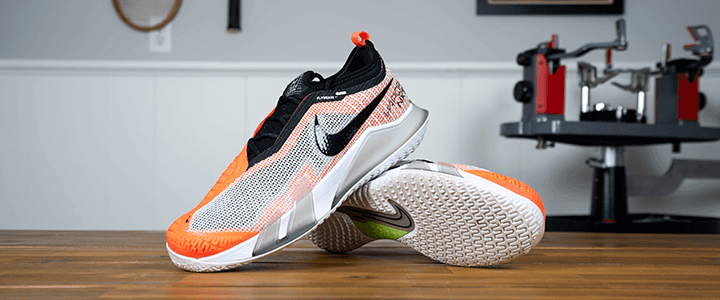
Although it’s hard to beat the bargain prices available for many cheap tennis shoes, there are a few tips you can keep in mind to buy top-of-the-line shoes for less.
Be Patient
If you can resist the urge to buy the latest tennis shoe model when it first comes out, retailers will eventually reward you with a discount.
Most retailers offer seasonal bargains, with the deepest discounts typically coming right before releasing a new model.
If you have a popular shoe size, this can become tricky as retailers eventually won’t backfill inventory for a shoe when a new model comes down the pipe, but it’s one route you can take.
Be Flexible With Colorways
Invariably, some colorways for a given shoe model will be more popular than others. If you can avoid buying the most popular, you’ll save some extra cash in the long run, as these shoes will feature deeper discounts to move inventory a few months after they’ve launched.
It might be unclear which colorways will have the highest demand when a shoe comes out, so you’ll have to watch retailer websites and emails to spot these deals.
Check All Retailers
If you’re used to buying your shoes from a website that specializes in tennis gear, consider broadening your horizons and checking other websites periodically.
The same holds if you most commonly buy your shoes on the most prominent retail sites – be sure to check some of the specialized stores, which often offer discounts to clear inventory.
Sign up for the email lists on various websites that sell tennis shoes so you know when one of their sales hits. You’ll want to be among the first to take advantage of these offers since sizes are often limited.
Where to Buy Cheap Tennis Shoes

Eager players can find inexpensive tennis shoes at various locations, but it pays to know where to dig up some of the best deals.
Here are some of the top websites for discovering bargain deals – so let’s explore some options.
Specialty Tennis Online Retailers
These retailers will be some of your best options for finding a great deal on tennis shoes. Although they specialize in tennis, they do a lot of business because enthusiasts appreciate their niche focus.
You’ll also find that these retailers tend to offer the broadest selection of styles and colorways with plenty of discounts throughout the year.
- Tennis Warehouse: San Luis Obispo, CA
- Tennis Express: Houston, TX
- Midwest Sports: Cincinnati, OH (now TennisPoint)
- Do It Tennis: San Marcos, CA
- Tennis Plaza: Orlando, FL
- Holabird Sports: Baltimore, MD
Outside of the US, Tennis-Point, based in Herzebrock-Clarholz, Germany, is an excellent online retailer to check out.
Speciality Local Retailers
These days, many players will research and explore products online before ever stepping into a local store. However, there’s often a missed opportunity to get advice from knowledgeable owners and score deals on shoes the same way you would with larger online retailers.
Plus, you’ll be able to try on various sizes to get the right fit, and if you find what you’re looking for, you’ll be able to take them home and use them the same day instead of waiting for shipping.
Here are a few places you might track down your next pair of shoes:
- Tennis Shop: Small, independently owned tennis shops may be fewer and far between these days, but they still exist, and it’s excellent when you can support them as their owners are members of your community. A quick search on your favorite search engine should help you dig up any nearby.
- Tennis Club: Tennis clubs often have pro shops and usually carry a limited gear supply. Although they’ll cater primarily to their members, they’re generally happy to sell to non-members.
- Public Tennis Facilities: Like tennis clubs, larger public tennis facilities will often have pro shops worth checking out if you want a deal on your next pair of shoes.
Of course, it won’t hurt to call them before you jump in your car to see if they have any shoes in stock.
Additional Online Retailers
Beyond specialty tennis retailers, plenty of other large online retailers carry shoes where you can find a great deal.
A few worth checking out are:
- Dick’s Sporting Goods
- Big 5 Sporting Goods
- Zappos
- Amazon
- Walmart
Of course, a few of these also have local big box stores to check out if you have one nearby.
7 Cheap Men’s Tennis Shoes
Although inexpensive, this affordable men’s tennis shoe selection offers fantastic performance, considering their price points.
I’ve pulled together a quick comparison of the shoes below, and you’ll find additional details for each shoe in the following sections.
Asics Gel Dedicate 7
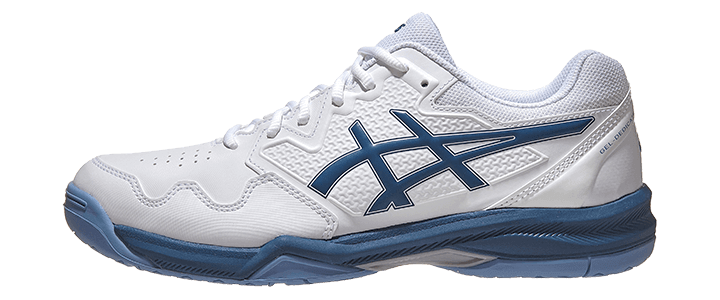
The Asics Gel Dedicate 7 comes with a mid-range price tag and delivers comfort in a mid-weight package.
This pair of shoes features a solid rubber outsole for durability, which delivers average abrasion resistance and provides plenty of traction.
At the midsole, the Gel Dedicate 7 uses GEL Cushioning and a standard EVA midsole, which will help absorb shock to provide comfort on all court surfaces.
Lastly, the shoe’s upper features synthetic leather to help ensure adequate support and a comfortable fit. Although I appreciate the material’s abrasion resistance, it doesn’t offer the best ventilation. If that’s a concern, opt for a lighter colorway.
Why We Love Them
- Comfort
- Weight
Area for Improvement
- Durability
Specs
| Size | True |
| Width | Medium |
| Arch Support | Medium-low |
| Weight | 13.0 ounces @ size 10.5 |
| Colors | Navy, White, Black, Blue |
Ratings
adidas CourtJam Control
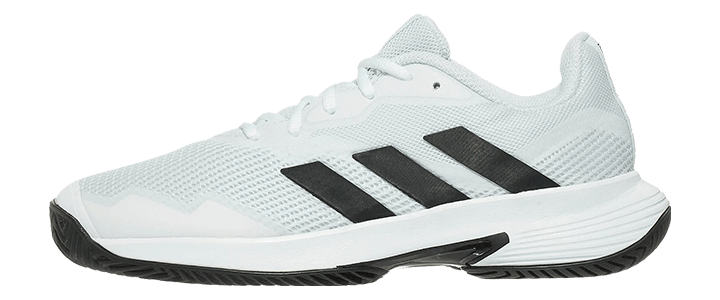
In many ways, the adidas CourtJam Control is a close cousin to the adidas Gamecourt – the next shoe on the list. Both are affordable mid-range shoes with a similar style, but a few differences make each unique.
They feature the same durable Adiwear rubber outsole with a near-identical tread pattern for starters.
However, one of the primary differences between the GameCourt is the midsole, which features adidas Bounce technology for comfort that offers excellent support but a bit of extra response or feel compared to the GameCourt.
The shoe’s upper is a blend of mesh to provide plenty of ventilation, and a toe cap at the shoe’s front adds a bit of extra durability.
Overall, the CourtJam Control is another affordable offering from adidas that delivers solid all-around performance.
Why We Love Them
- Comfort
- Weight
Area for Improvement
- Stability
Specs
| Size | Slightly large |
| Width | Wider in front |
| Arch Support | Medium-low |
| Weight | 13.9 ounces @ size 10.5 |
| Colors | Black, White, Grey |
Ratings
adidas GameCourt 2

The adidas GameCourt 2 is one of my favorite mid-range tennis shoes that offers excellent lightweight comfort.
The outsole is the same Adiwear rubber you’ll find across adidas’ range of tennis shoes, providing plenty of grip in a herringbone pattern.
The shoe’s midsole uses Cloudfoam, one of my favorite materials for comfort, which offers plenty of impact-resistant cushioning.
Lastly, the shoe’s upper is comfortable but leaves us wanting in the stability and durability category. More specifically, I’d love to see more cushioning in the heel’s collar and some extra durable material covering the front of the foot.
However, tennis players looking for affordable shoes that provide excellent comfort should check out the adidas GameCourt.
Why We Love Them
- Comfort
- weight
Area for Improvement
- Stability
Specs
| Size | True |
| Width | Medium |
| Arch Support | Medium |
| Weight | 12.9 ounces @ size 10.5 |
| Colors | Black, Grey, White |
Ratings
adidas Adizero Club 2
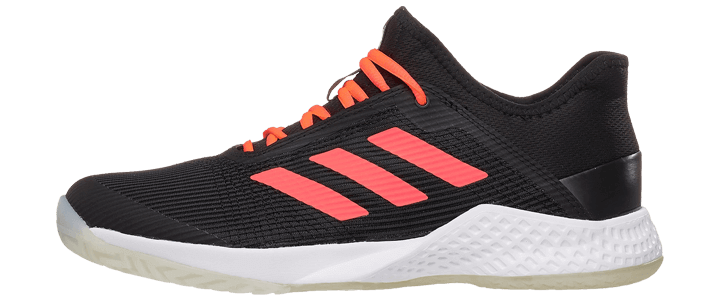
If you’re looking for an affordable men’s tennis shoe with excellent lightweight performance, the adidas Adizero Club 2 is worth considering.
The shoe’s outsole features Adiwear, durable non-marking rubber in an all-court pattern to help provide traction.
The midsole provides the majority of a shoe’s comfort. For the Adizero Club 2, you’ll find Adiprene+ at the shoe’s heel for extra shock absorption and comfort, which, combined with a high-quality EVA midsole, ensures a smooth ride. The midfoot section also features adidas’ SprintFrame, a lightweight chassis for stability.
The Adizero Club 2’s upper mesh bootie construction provides a secure fit and integrates Climacool to wick away sweat for maximum comfort. The shoe also takes strategic advantage of Adituff for the shoe’s toe cap and the inside edge to protect against abrasion.
One area where the shoe could improve is durability.
Why We Love Them
- Lightweight
- Comfort
Area for Improvement
- Durability
Specs
| Size | True |
| Width | Medium |
| Arch Support | Medium |
| Weight | 12.7 ounces @ size 10.5 |
| Colors | Black, White, Grey, Blue |
Ratings
Asics Gel-Game 8

Another all-around performer that’s easy on the wallet is the Asics Gel-Game 8, which offers comfort and stability.
For the shoe’s outsole, you’ll find a durable, non-marking rubber with a reliable tread to provide traction on any court surface.
The shoe treats players to Asics’ Gel Cushioning for a shock-absorbing midsole and combines it with a quality EVA foam to provide a high-comfort ride on all court surfaces.
Furthermore, it incorporates Asics’ mid-foot Trusstic technology to improve the shoe’s stability and prevent unwanted twisting during sharp movements.
Lastly, the Asics Gel-Game 8 offers a breathable mesh upper with a synthetic leather overlay for added support and durability. Like many of the shoes in the more affordable range, I’d love to see more durability in this shoe.
Why We Love Them
- Comfort
- Stability
Area for Improvement
- Durability
Specs
| Size | True |
| Width | Medium |
| Arch Support | Medium |
| Weight | 13 ounces @ size 10.5 |
| Colors | Black, White, Red, Blue |
Ratings
Asics Gel Court Speed
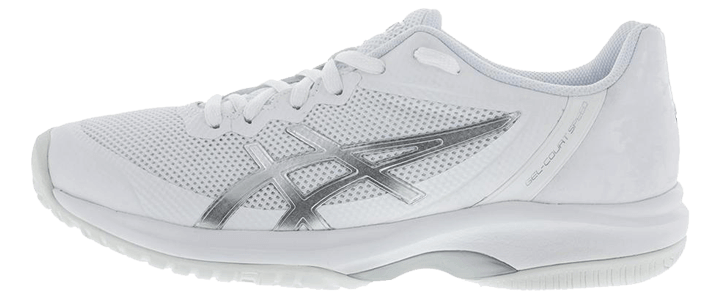
The Asics Gel Court Speed is an inexpensive yet popular tennis shoe that offers comfort in a responsive, lightweight package.
The shoe features a durable two-piece rubber setup in a herringbone-style pattern for the outsole. A mid-foot Trusstic system separates the outsole in the middle for stability.
The midsole comes with generous EVA foam to provide comfort throughout the length of the shoe, as well as gel cushioning at the heel and ball of your foot for extra shock absorption.
At the top of the Gel Court Speed, you’ll find a comfortable mesh wrapped with synthetic material for added protection, and Asics’ PGaurd Toe Protectors helps resist abrasion that’s common in that area.
My main knock on the shoe would be durability, like others on the list.
Why We Love Them
- Comfort
- Stability
Area for Improvement
- Durability
Specs
| Size | True |
| Width | Medium |
| Arch Support | Medium |
| Weight | 13.1 ounces @ size 10.5 |
| Colors | Black, White, Yellow, Blue |
Ratings
Prince T-22.5

The Prince T-22.5 is the evolution of the T-22, a time-tested, affordable tennis shoe with a respectable following of users who appreciate the shoe’s stability and comfort.
PRC 1000 makes up the shoe’s outsole to provide durability with a tread pattern that’s ideal for hard courts but will perform well on various surfaces.
The shoe’s midsole comes with standard EVA foam to provide all-over comfort. However, players benefit from added shock absorption with a ShockEraser unit at the heel and a SoftSprint insert at the shoe’s front. A wYshbone mid-foot shank at the middle of the shoe provides stability.
For the upper, the T-22 features an open mesh construction for ventilation. Prince wraps it with a few synthetic materials for added stability and a toe cap for durability upfront.
The primary drawback of this shoe is its weight, but they’ve improved upon it from the prior generation.
Why We Love Them
- Stability
- Comfort
Area for Improvement
- Weight
Specs
| Size | True |
| Width | Medium |
| Arch Support | Medium-low |
| Weight | 15.3 ounces @ size 10.5 |
| Colors | Black, White |
Ratings
7 Cheap Women’s Tennis Shoes
If you’re looking for bargain performance that doesn’t disappoint, you’ll love my picks for these inexpensive women’s tennis shoes.
Below, I’ve provided a quick comparison of each shoe and then dive into extra details about them in the following sections.
K-Swiss Hypercourt Express 2
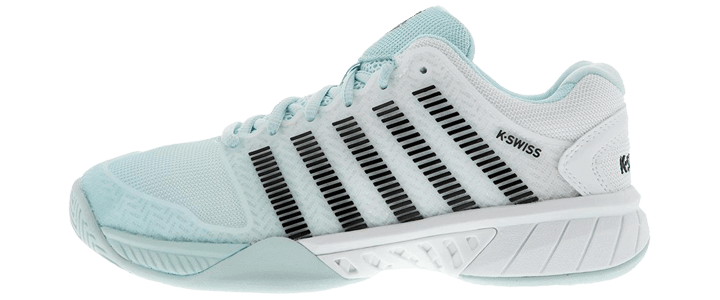
The K-Swiss Hypercourt Express 2 is a popular tennis shoe for women, offering comfort and stability in several colors.
The shoe’s outsole uses Aosta 7 rubber from K-Swiss, a durable material that resists abrasion while providing excellent traction.
An EVA foam sole provides cushion at the shoe’s midsole, while a more rigid plastic insert in the middle of the foot provides stability.
The K-Swiss Hypercourt Express 2 features a breathable mesh upper with a Durawrap overlay for protection and extra support.
Finally, this shoe features a special insole that helps manage moisture through ventilation underfoot for added comfort.
The shoe’s main downside is durability, often a drawback to shoes with a lower price point.
Why We Love Them
- Comfort
- Stability
Area for Improvement
- Durability
Specs
| Size | True |
| Width | Medium |
| Arch Support | Low |
| Weight | 10.6 ounces @ size 7.5 |
| Colors | Black, White, Grey, Red, Pink, Blue |
Ratings
Asics Gel Dedicate 7

The women’s Asics Gel Dedicate 7 is one of my favorite mid-range tennis shoes for women that offers comfort and stability at an affordable price.
The shoe’s outsole has a solid rubber with a familiar herringbone-style pattern for all-court grip and durability. You’ll also find a generous toe guard at the front of the shoe for enhanced protection.
The Gel Dedicate 7 combines Asics’ Gel Cushioning System to help absorb the harsh impact your feet sustain on hard courts with a responsive and lightweight EVA foam for added comfort. As you’ll find in most Asics tennis shoes, a mid-foot shank sits at the shoe’s bottom to provide stability and prevent twisting.
You’ll find durable synthetic leather for the upper, which provides stability without sacrificing comfort, but it could offer better ventilation.
At its price, the main drawback is durability.
Why We Love Them
- Comfort
- Stability
Area for Improvement
- Durability
Specs
| Size | True |
| Width | Medium |
| Arch Support | Medium |
| Weight | 10.1 ounces @ size 7.5 |
| Colors | White, Black, Blue |
Ratings
adidas CourtJam Control

Another mid-range shoe that provides solid all-around performance is the adidas CourtJam Control, which is comfortable and well-ventilated.
The shoe’s outsole comes with Adiwear, a durable rubber that offers excellent traction and is well-suited for a broad range of courts.
The midsole uses Bounce, a proprietary EVA foam from adidas, to deliver shock absorption and a comfortable ride. At the same time, a rigid mid-foot shank provides stability and helps limit the twisting of the shoe.
Lastly, the adidas CourtJam Control’s upper helps keep your feet cool and comfortable with a soft mesh and a more durable TPU material as an outer wrap to provide added protection and stability.
The CourtJam Control does most things well, but some may find it lacks a bit in the stability department.
Why We Love Them
- Comfort
- Ventilation
Area for Improvement
- Stability
Specs
| Size | Slightly large |
| Width | Wider in front |
| Arch Support | Low |
| Weight | 12.1 ounces @ size 7.5 |
| Colors | White, Grey, Pink |
Ratings
adidas GameCourt 2
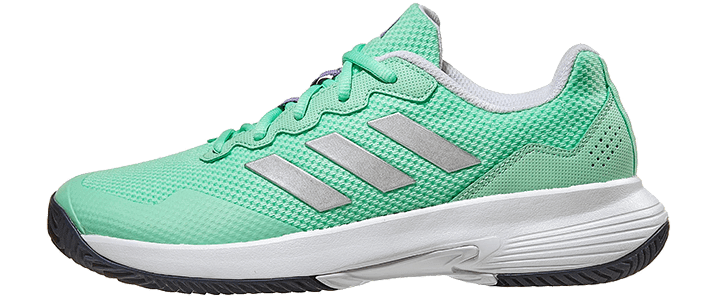
Another of my favorite wallet-friendly shoes from adidas is the GameCourt 2, which, like the CourtJam model, offers comfort and all-around performance.
The shoe’s outsole features reliable Adiwear rubber for exceptional traction and a tread pattern that performs well on all court surfaces.
The GameCourt uses its Cloudfoam EVA midsole to deliver a smooth ride and shock absorption for comfort.
The upper’s full bootie construction offers comfort to complete the shoe while keeping it lightweight and breathable.
Like the CourtJam Control, I wish they provided more stability.
Why We Love Them
- Comfort
- Ventilation
Area for Improvement
- Stability
Specs
| Size | True |
| Width | Medium |
| Arch Support | Medium |
| Weight | 10.8 ounces @ size 7.5 |
| Colors | Black, White |
Ratings
Asics Gel-Game 8

An affordable shoe from Asics, the Gel-Game 8 is comfortable without sacrificing stability.
The shoe’s outsole features a durable rubber with plenty of traction that you can use on any court surface.
The midsole uses Asics’ Gel Cushioning with an embedded Trusstic mid-foot shank that’s stiff at the shoe’s midfoot for stability.
The no-frills upper is lightweight and breathable to help keep your feet cool and showcases extra durability around the toes.
All in all, this is a great shoe, but it could be more durable.
Why We Love Them
- Weight
- Stability
Area for Improvement
- Durability
Specs
| Size | True |
| Width | Medium-tight |
| Arch Support | Medium-low |
| Weight | 10.5 ounces @ size 7.5 |
| Colors | Black, White, Grey, Red, Blue, Pink |
Ratings
Asics Gel Court Speed

Another terrific offering from Asics is the Gel Court Speed, a mid-range shoe with excellent performance on the court.
The outsole comes with Asics High Abrasion Rubber for the same all-court traction you’ll find in the top-of-the-line Asics models.
At the midsole, you’ll find super comfortable FlyteFoam, one of the shoe’s more significant upgrades from the last model. Asics adds a supportive Trusstic resin shank for stability to prevent twisting in the middle.
Finally, the shoe’s upper is a comfortable, breathable mesh that provides adequate stability.
I’d love to see the shoe offer more durability, but it’s an excellent offering from Asics.
Why We Love Them
- Comfort
- Stability
Area for Improvement
- Durability
Specs
| Size | True |
| Width | Medium |
| Arch Support | Low |
| Weight | 10.5 ounces @ size 7.5 |
| Colors | White, Black, Navy, Pink, Yellow |
Ratings
Prince T-22.5
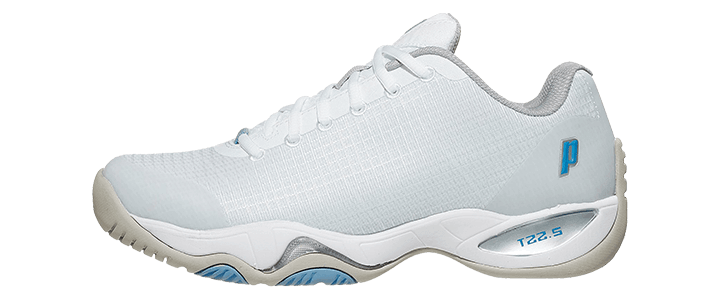
As Prince’s most popular women’s tennis shoe, the T-22 stands the test of time, providing players with comfort and stability. However, the T-22.5 is the company’s latest update and an excellent refresh.
The durable PRC 1000 outsole has a herringbone-style tread that seeks to bump up traction and works on a wide range of court surfaces.
The midsole of the T-22s comes with Prince’s ShockEraser unit at the heel and installs SoftSpring technology at the front of the shoe for dealing with impact. An EVA foam completes the midsole to provide comfort, while a wYshbone mid-foot shank ensures stability.
For the upper, you’ll find breathable mesh, which Prince protects by wrapping with a mix of synthetic materials that add to the shoe’s stability and serve to ward off hard court abrasion.
The main knock on the shoe is its weight, which may feel heavy for some players used to other shoes in this price range. However, the latest generation is lighter than the older model.
Why We Love Them
- Stability
- Comfort
Area for Improvement
- Weight
Specs
| Size | True |
| Width | Medium |
| Arch Support | Medium |
| Weight | 13.1 ounces @ size 7.5 |
| Colors | White, Blue |
Ratings
Wrapping Up
As you can see, plenty of affordable men’s and women’s tennis shoes are available, which also offer essential features to keep you healthy and performing your best.
When you’re first starting, an inexpensive shoe might be the ideal choice, but learning about the different types of tennis shoes can help you decide which to buy now and in the future.
Hopefully, this guide helped you find your next pair of shoes or, at the very least, helped point you in the right direction.
I’d love to hear from you in the comments below if you have questions about any of the shoes or have another pair of reasonably priced shoes to share.
Play Better Tennis
Improve your game alongside our community of tennis players
Why join?
Discussion Boards
Join the conversation with other members of the community.
5 Point Friday
Read our weekly recap of the 5 most interesting things we dig up in tennis.

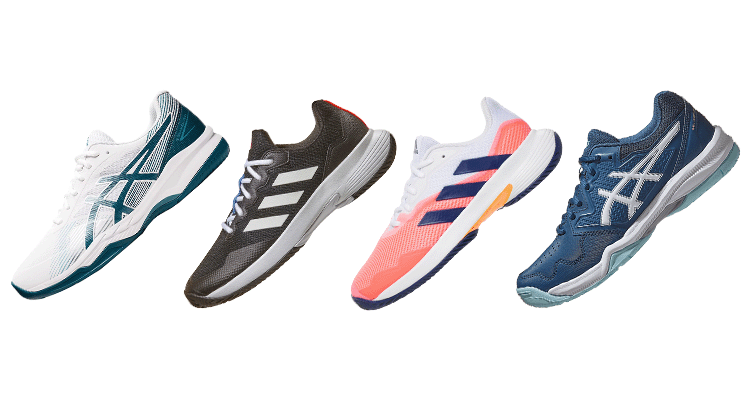

Leave a Reply
Want to join the discussion?Feel free to contribute!